Fiber Ring Laser Directional Torsion Sensor with Ultra-Wide Linear Response
Abstract
:1. Introduction
2. Principles
3. Experiments and Results
4. Conclusions
Author Contributions
Funding
Conflicts of Interest
References
- Deng, M.; Xu, J.; Zhang, Z.; Bai, Z.; Liu, S.; Wang, Y.; Zhang, Y.; Liao, C.; Jin, W.; Peng, G.; et al. Long period fiber grating based on periodically screw-type distortions for torsion sensing. Opt. Express 2017, 25, 14308–14316. [Google Scholar] [CrossRef] [PubMed]
- Xian, L.; Wang, P.; Li, H. Power-interrogated and simultaneous measurement of temperature and torsion using paired helical long-period fiber gratings with opposite helicities. Opt. Express 2014, 22, 20260–20267. [Google Scholar] [CrossRef] [PubMed]
- Tian, X.G.; Tao, X.M. Torsion measurement using fiber Bragg grating sensors. Expr. Mech. 2001, 41, 248–253. [Google Scholar] [CrossRef]
- Zhang, X.; Chen, J.; González-Vila, Á.; Liu, F.; Liu, Y.; Li, K.; Guo, T. Twist sensor based on surface plasmon resonance excitation using two spectral combs in one tilted fiber Bragg grating. J. Opt. Soc. Am. B 2019, 36, 1176–1182. [Google Scholar] [CrossRef]
- Shen, C.; Zhang, Y.; Zhou, W.; Albert, J. Au-coated tilted fiber Bragg grating twist sensor based on surface plasmon resonance. Appl. Phys. Lett. 2014, 104, 071106. [Google Scholar] [CrossRef] [Green Version]
- Yiping, W.; Wang, M.; Huang, X. In fiber Bragg grating twist sensor based on analysis of polarization dependent loss. Opt. Express 2013, 21, 11913–11920. [Google Scholar] [CrossRef] [PubMed]
- Huerta-Mascotte, E.; Sierra-Hernandez, J.M.; Mata-Chavez, R.I.; Jauregui-Vazquez, D.; Castillo-Guzman, A.; Estudillo-Ayala, J.M.; Guzman-Chavez, A.D.; Rojas-Laguna, R. A Core-Offset Mach Zehnder Interferometer Based on A Non-Zero Dispersion-Shifted Fiber and Its Torsion Sensing Application. Sensors 2016, 16, 856. [Google Scholar] [CrossRef] [PubMed]
- Dong, Y.; Sun, C.; Xiao, H.; Dong, C.; Jian, S. Twist and temperature characteristics of the PD-NSN fiber structure based on in-line Mach-Zehnder interferometer. Opt. Fiber Technol. 2017, 33, 39–44. [Google Scholar] [CrossRef]
- Fu, Q.; Zhang, J.; Liang, C.; Ikechukwu, I.P.; Yin, G.; Lu, L.; Shao, Y.; Liu, L.; Liu, D.; Zhu, T. Intensity-modulated directional torsion sensor based on in-line optical fiber Mach–Zehnder interferometer. Opt. Lett. 2018, 43, 2414–2417. [Google Scholar] [CrossRef]
- Song, B.; Miao, Y.; Lin, W.; Zhang, H.; Wu, J.; Liu, B. Multi-mode interferometer-based twist sensor with low temperature sensitivity employing square coreless fibers. Opt. Express 2013, 21, 26806–26811. [Google Scholar] [CrossRef] [PubMed]
- Chen, W.; Lou, S.; Wang, L.; Zou, H.; Lu, W.; Jian, S. Highly Sensitive Torsion Sensor Based on Sagnac Interferometer Using Side-Leakage Photonic Crystal Fiber. IEEE Photonics Technol. Lett. 2011, 23, 1639–1641. [Google Scholar] [CrossRef]
- Zu, P.; Chan, C.C.; Jin, Y.; Gong, T.; Zhang, Y.; Chen, L.H.; Dong, X. A Temperature-Insensitive Twist Sensor by Using Low-Birefringence Photonic-Crystal-Fiber-Based Sagnac Interferometer. IEEE Photonics Technol. Lett. 2011, 23, 920–922. [Google Scholar] [CrossRef] [Green Version]
- Kim, H.; Kim, T.; Kim, B.; Chung, Y. Temperature-Insensitive Torsion Sensor With Enhanced Sensitivity by Use of a Highly Birefringent Photonic Crystal Fiber. IEEE Photonics Technol. Lett. 2010, 22, 1539–1541. [Google Scholar] [CrossRef]
- Song, B.; Zhang, H.; Miao, Y.; Lin, W.; Wu, J.; Liu, H.; Yan, D.; Liu, B. Highly sensitive twist sensor employing Sagnac interferometer based on PM-elliptical core fibers. Opt. Express 2015, 23, 15372–15379. [Google Scholar] [CrossRef]
- Shao, L.; Zhang, X.; He, H.; Zhang, Z.; Zou, X.; Luo, B.; Pan, W.; Yan, L. Optical Fiber Temperature and Torsion Sensor Based on Lyot-Sagnac Interferometer. Sensors 2016, 16, 1774. [Google Scholar] [CrossRef]
- Wu, J.; Shen, X.; Luo, X.; Hu, X.; Peng, J.; Yang, L.; Li, J.; Dai, N. Temperature-insensitive torsion sensor with sensitivity-enhanced by processing a polarization-maintaining photonic crystal fiber. Opt. Commun. 2017, 401, 80–84. [Google Scholar] [CrossRef]
- Huang, B.; Shu, X. Highly sensitive torsion sensor with femtosecond laser-induced low birefringence single-mode fiber based Sagnac interferometer. Opt. Express 2018, 26, 4563–4571. [Google Scholar] [CrossRef]
- Silva, R.M.; Ferreira, M.S.; Frazão, O. Temperature independent torsion sensor using a high-birefringent Sagnac loop interferometer. Opt. Commun. 2012, 285, 1167–1170. [Google Scholar] [CrossRef]
- Qian, Y.; Sun, B.; Wan, H.; Zhang, Z. Novel temperature-independent microfiber sensor fabricated with the tapering-twisting-tapering technique. Appl. Opt. 2019, 58, 3091–3096. [Google Scholar] [CrossRef]
- Chen, Y.; Semenova, Y.; Farrell, G.; Xu, F.; Lu, Y. A Compact Sagnac Loop Based on a Microfiber Coupler for Twist Sensing. IEEE Photonics Technol. Lett. 2015, 27, 2579–2582. [Google Scholar] [CrossRef]
- Liu, C.; Jiang, Y.; Du, B.; Wang, T.; Feng, D.; Jiang, B.; Yang, D. Strain-insensitive twist and temperature sensor based on seven-core fiber. Sens. Actuators A Phys. 2019, 290, 172–176. [Google Scholar] [CrossRef]
- Tan, F.; Liu, Z.; Tu, J.; Yu, C.; Lu, C.; Tam, H.-Y. Torsion sensor based on inter-core mode coupling in seven-core fiber. Opt. Express 2018, 26, 19835–19844. [Google Scholar] [CrossRef]
- Liu, D.; Kumar, R.; Wei, F.; Han, W.; Mallik, A.K.; Yuan, J.; Yu, C.; Kang, Z.; Li, F.; Liu, Z.; et al. Highly Sensitive Twist Sensor Based on Partially Silver Coated Hollow Core Fiber Structure. J. Lightwave Technol. 2018, 36, 3672–3677. [Google Scholar] [CrossRef] [Green Version]
- Huang, B.; Shu, X.; Du, Y. Intensity modulated torsion sensor based on optical fiber reflective Lyot filter. Opt. Express 2017, 25, 5081–5090. [Google Scholar] [CrossRef]
- Shi, J.; Wang, Y.; Xu, D.; Zhang, H.; Su, G.; Duan, L.; Yan, C.; Yan, D.; Fu, S.; Yao, J. Temperature Sensor Based on Fiber Ring Laser With Sagnac Loop. IEEE Photonics Technol. Lett. 2016, 28, 794–797. [Google Scholar] [CrossRef]
- Sun, C.; Wang, M.; Liu, J.; Ye, S.; Liang, L.; Jian, S. Fiber Ring Cavity Laser Based on Modal Interference for Curvature Sensing. IEEE Photonics Technol. Lett. 2016, 28, 923–926. [Google Scholar] [CrossRef]
- Zhang, W.; Ying, Z.; Yuan, S.; Tong, Z. A fiber laser sensor for liquid level and temperature based on two taper structures and fiber Bragg grating. Opt. Commun. 2015, 342, 243–246. [Google Scholar] [CrossRef]
- Li, C.; Ning, T.; Li, J.; Zhang, C.; Zhang, C.; Lin, H.; Pei, L. Fiber-Optic Laser Sensor Based on All-Fiber Multipath Mach–Zehnder Interferometer. IEEE Photonics Technol. Lett. 2016, 28, 1908–1911. [Google Scholar] [CrossRef]
- Cai, L.; Zhao, Y.; Li, X. A fiber ring cavity laser sensor for refractive index and temperature measurement with core-offset modal interferometer as tunable filter. Sens. Actuators B Chem. 2017, 242, 673–678. [Google Scholar] [CrossRef]
- Xie, W.-G.; Zhang, Y.-N.; Wang, P.-Z.; Wang, J.-Z. Optical Fiber Sensors Based on Fiber Ring Laser Demodulation Technology. Sensors 2018, 18, 505. [Google Scholar] [CrossRef]
- Guan, B.-O.; Jin, L.; Zhang, Y.; Tam, H.-Y. Polarimetric Heterodyning Fiber Grating Laser Sensors. J. Lightwave Technol. 2012, 30, 1097–1112. [Google Scholar] [CrossRef]
- Yin, B.; Wu, S.; Wang, M.; Liu, W.; Li, H.; Wu, B.; Wang, Q. High-sensitivity refractive index and temperature sensor based on cascaded dual-wavelength fiber laser and SNHNS interferometer. Opt. Express 2019, 27, 252–264. [Google Scholar] [CrossRef]
- Shi, L.; Zhu, T.; Fan, Y.; Chiang, K.S.; Rao, Y. Torsion sensing with a fiber ring laser incorporating a pair of rotary long-period fiber gratings. Opt. Commun. 2011, 284, 5299–5302. [Google Scholar] [CrossRef]
- Díaz, C.A.R.; Leal-Junior, A.G.; Marques, C.; Leitão, C.; de Brito André, P.S.; Antunes, P.F.C.; Pontes, M.J.; Frizera-Neto, A.; Ribeiro, M.R.N. Combined Bending and Torsion Sensing by Induced Birefringence in Distributed Bragg Reflector Laser. J. Lightwave Technol. 2019, 37, 861–867. [Google Scholar] [CrossRef]
- Liu, Y.; Liu, B.; Feng, X.; Zhang, W.; Zhou, G.; Yuan, S.; Kai, G.; Dong, X. High-birefringence fiber loop mirrors and their applications as sensors. Appl. Opt. 2005, 44, 2382–2390. [Google Scholar] [CrossRef]
- Kim, C.-S.; Lee, T.H.; Yu, Y.S.; Han, Y.-G.; Lee, S.B.; Jeong, M.Y. Multi-point interrogation of FBG sensors using cascaded flexible wavelength-division Sagnac loop filters. Opt. Express 2006, 14, 8546–8551. [Google Scholar] [CrossRef]
- Sun, C.; Wang, M.; Jian, S. Experimental and theoretical study of the in- fiber twist sensor based on quasi-fan Solc structure filter. Opt. Express 2017, 25, 19955–19965. [Google Scholar] [CrossRef]
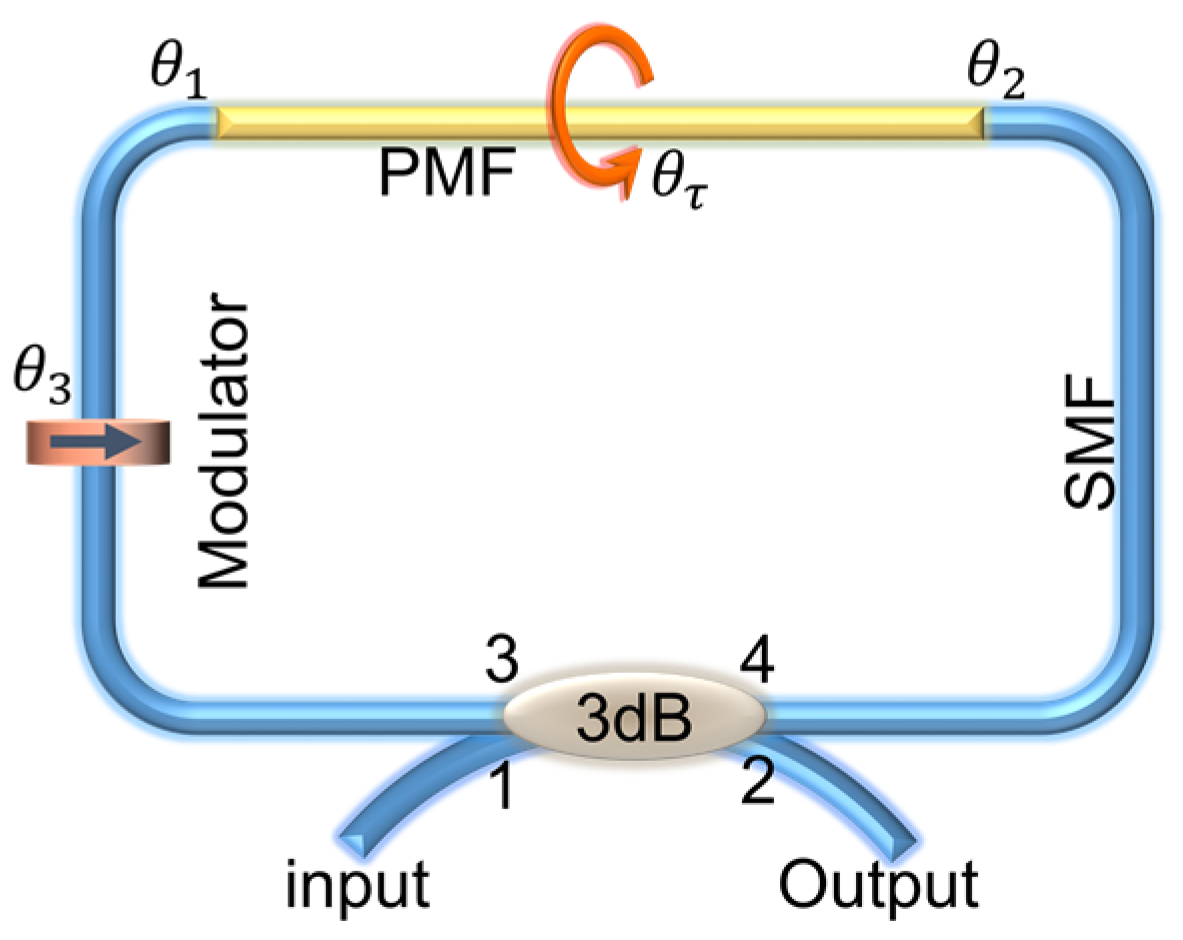
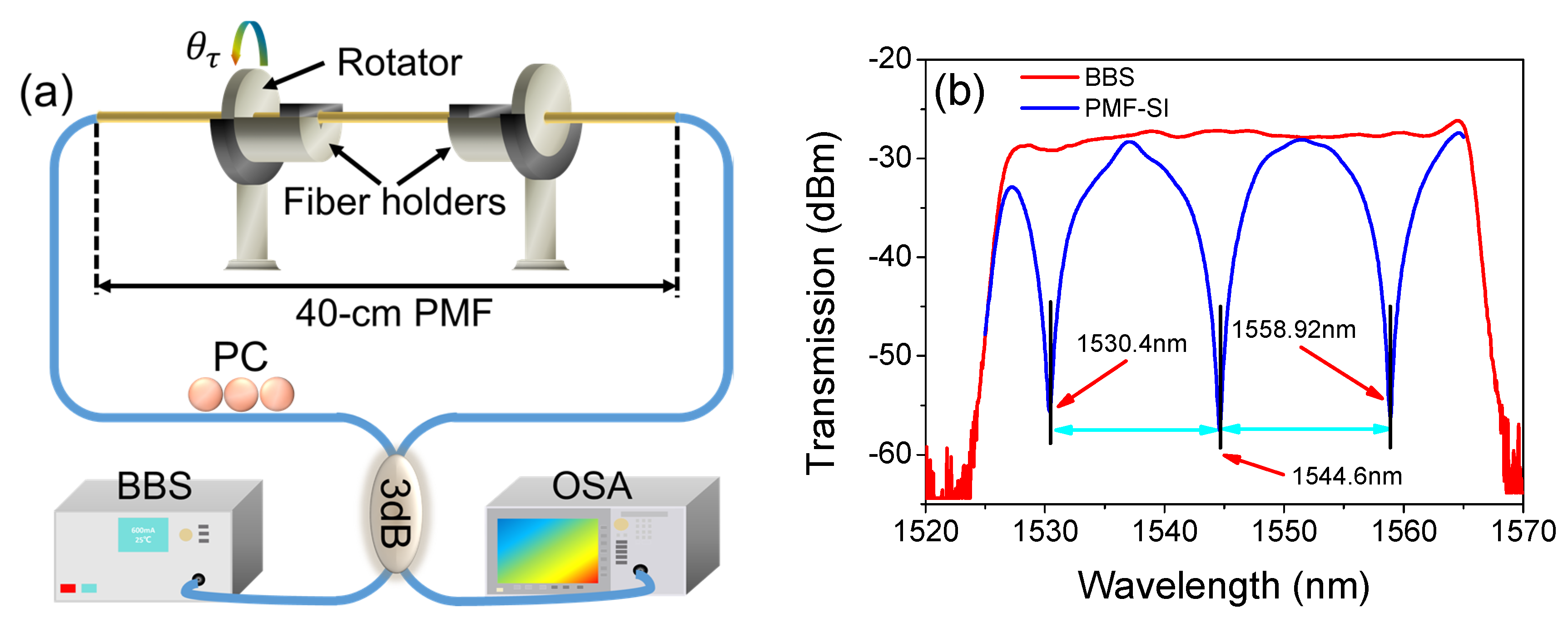
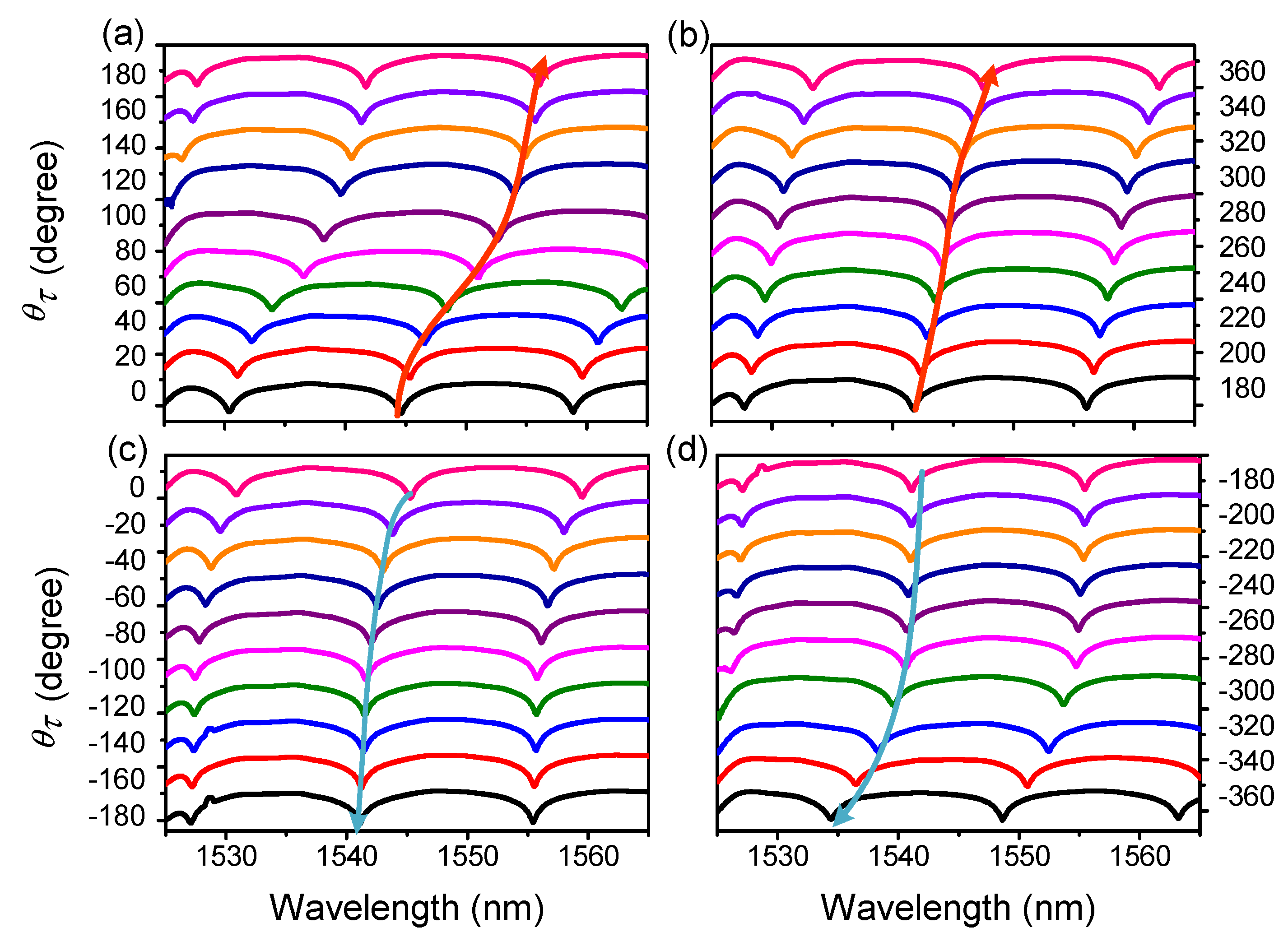
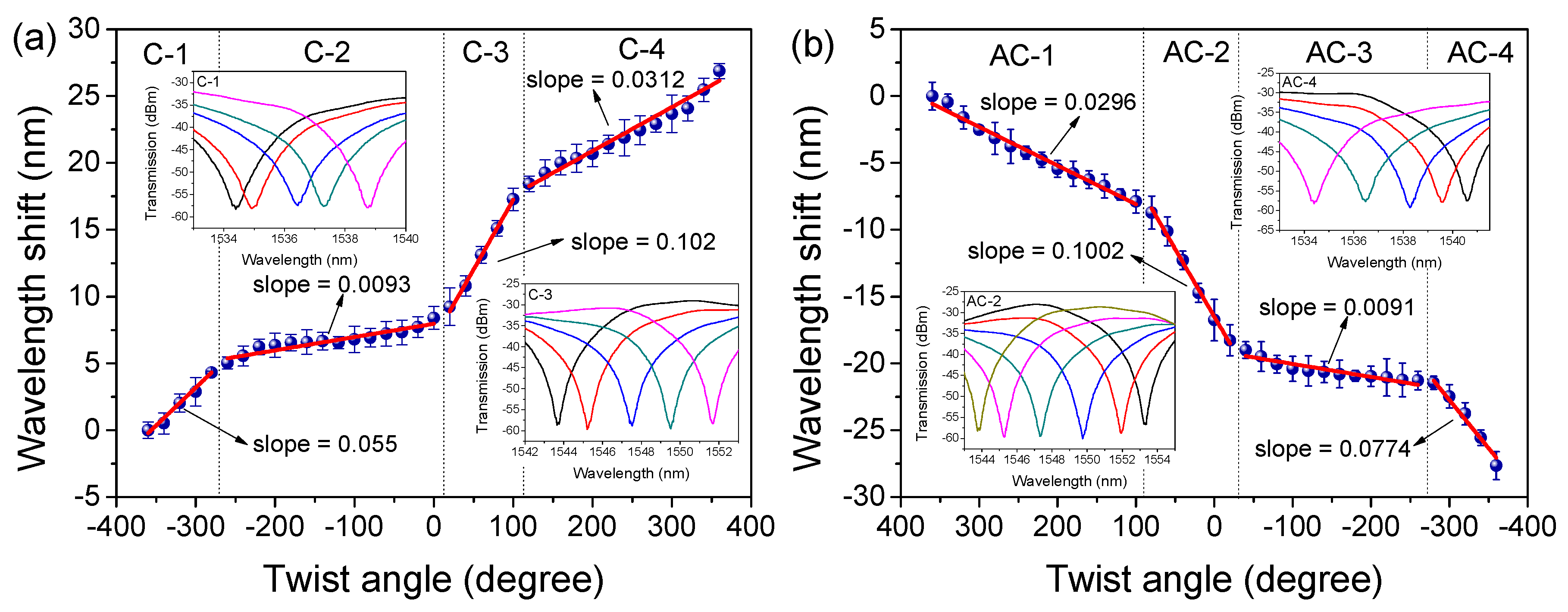
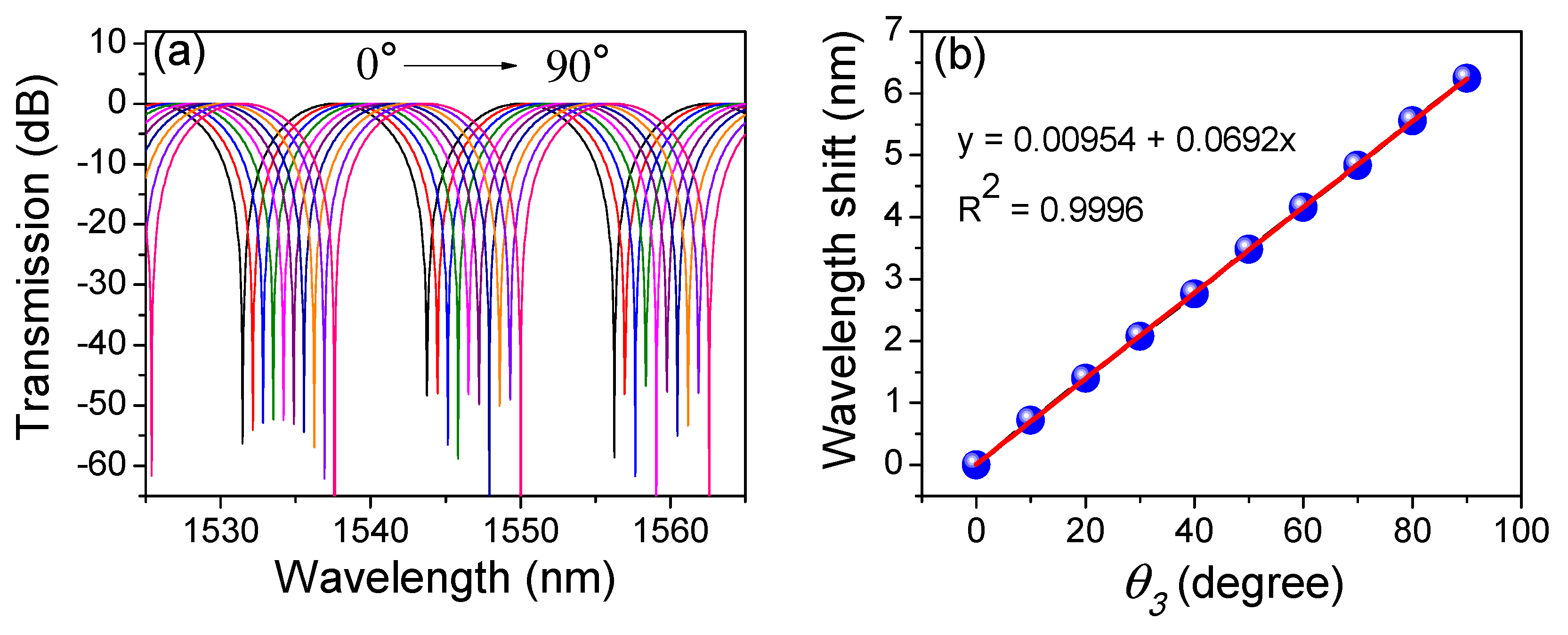
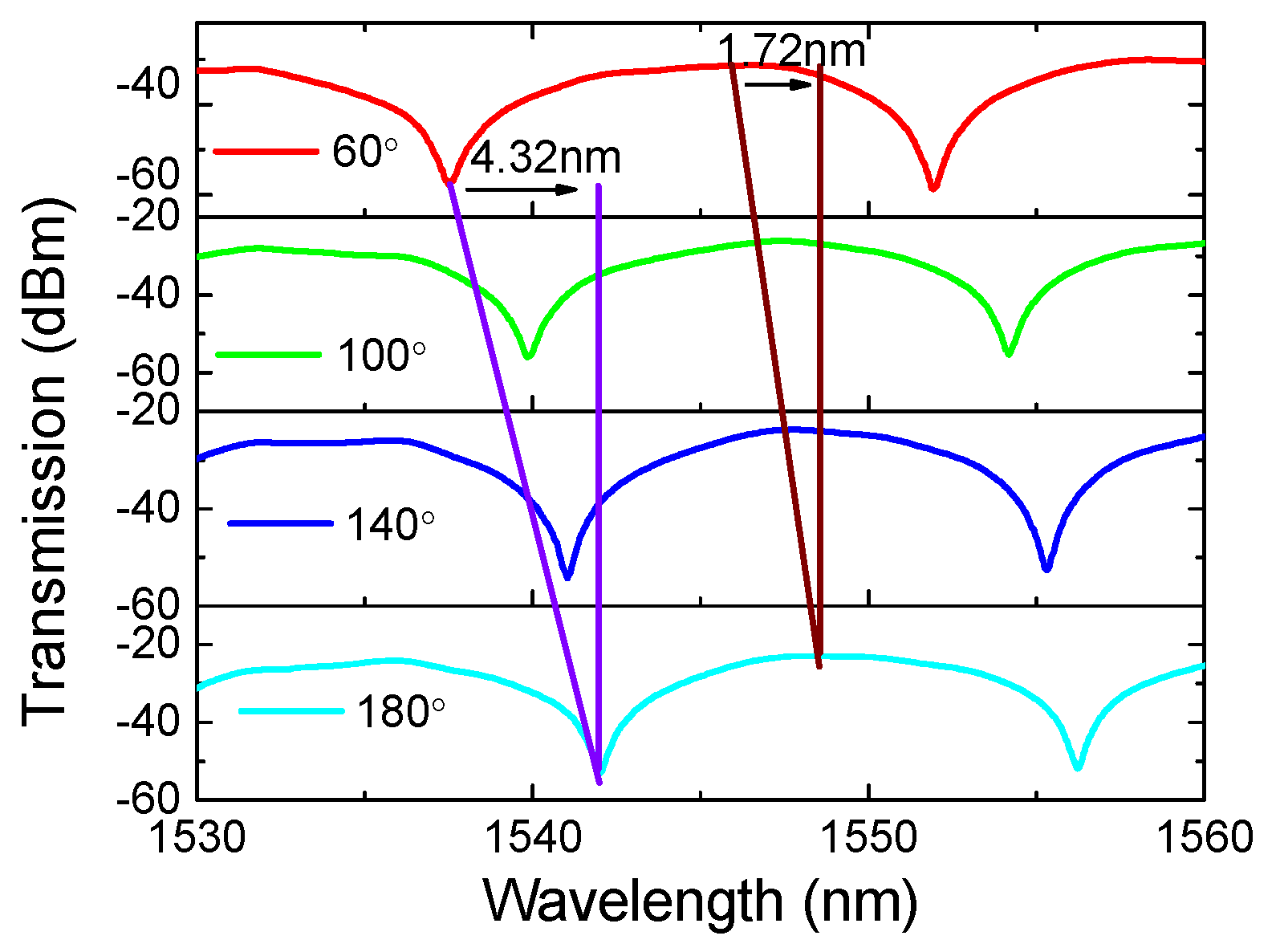

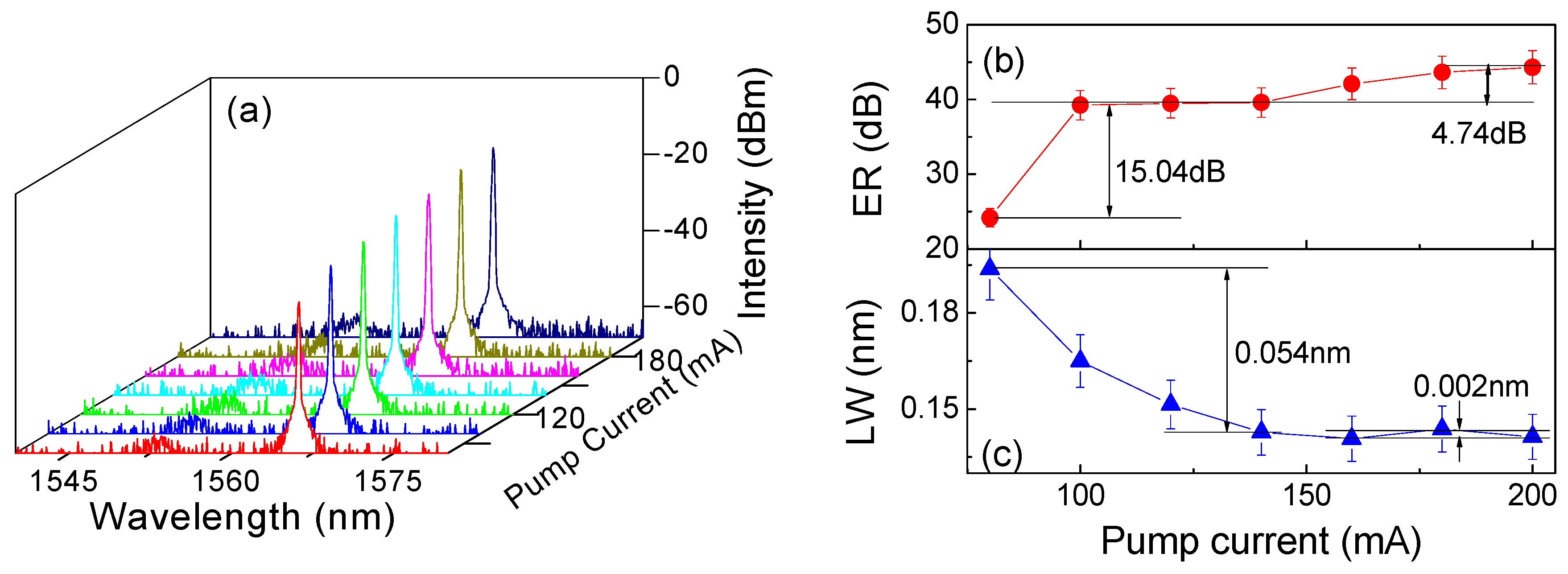
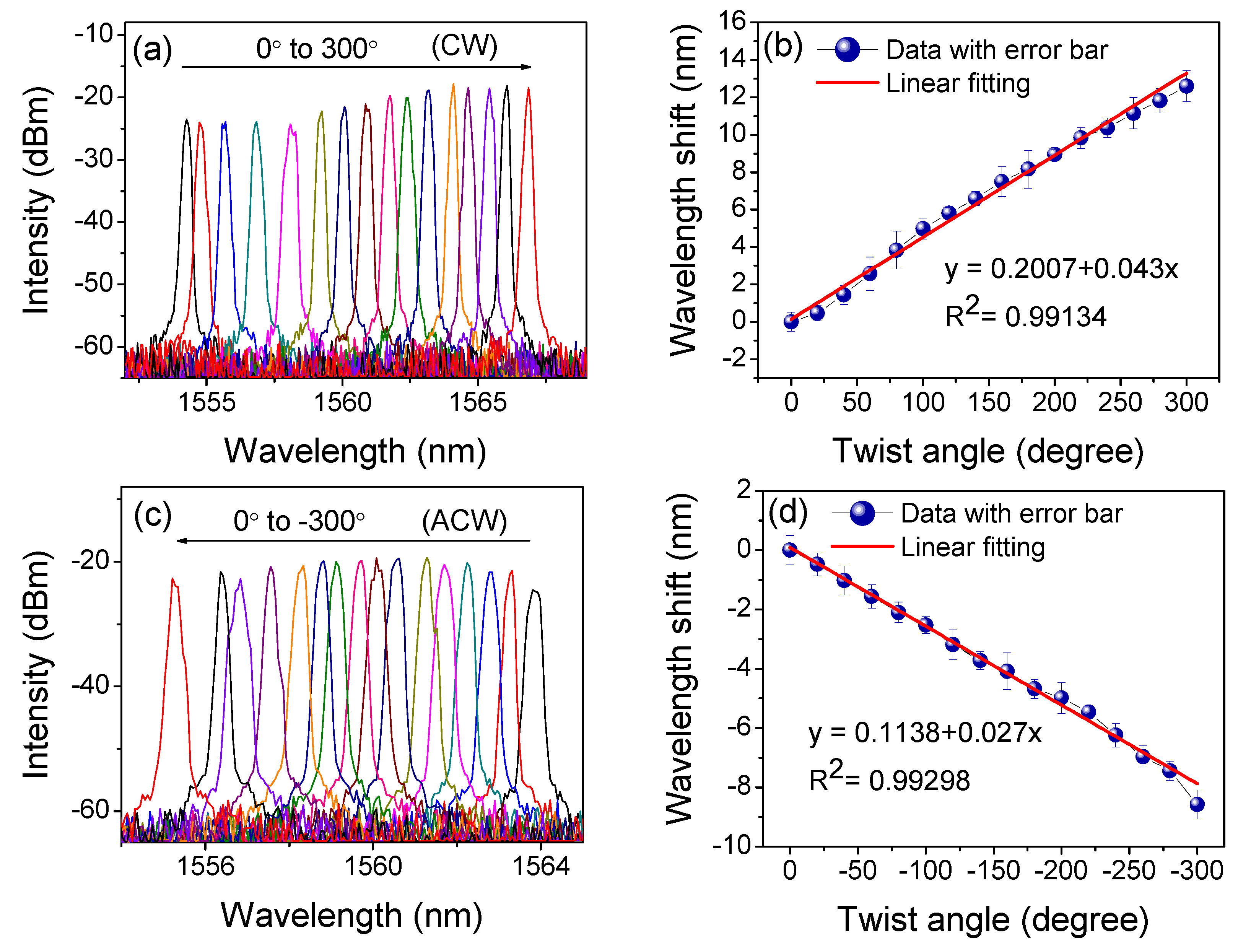


| Structures | Linear Response Range | Sensitivity | Direction | Refs. |
|---|---|---|---|---|
| photonic crystal fiber-based SI | approx. −90 to 90 deg | 0.059 nm/deg | Yes | [13] |
| elliptical-core PMF-based SI | approx.−120 to 120 deg | 0.68 nm/deg | Yes | [14] |
| low birefringence SMF-based SI | 180~270 deg | 3.26 nm/deg | No | [17] |
| tapered seven-core fiber | 540~640 deg | 0.88 nm/deg | Yes | [22] |
| reflective Lyot filter | 10~50 deg | 20.336 dB/rad | No | [24] |
| quasi-fan Solc filter | 40~90 deg | 1.27 dB/(rad/m) | No | [37] |
| HLPG-based FLTS | −100 to 100 rad/m | 0.084 nm(rad/m) | Yes | [33] |
| SI-based FLTS | ±300 deg (±175 rad/m) | 2.46 nm/rad | Yes | This work |
© 2019 by the authors. Licensee MDPI, Basel, Switzerland. This article is an open access article distributed under the terms and conditions of the Creative Commons Attribution (CC BY) license (http://creativecommons.org/licenses/by/4.0/).
Share and Cite
Liu, X.; Wang, F.; Yang, J.; Zhang, X.; Du, X. Fiber Ring Laser Directional Torsion Sensor with Ultra-Wide Linear Response. Sensors 2019, 19, 3613. https://doi.org/10.3390/s19163613
Liu X, Wang F, Yang J, Zhang X, Du X. Fiber Ring Laser Directional Torsion Sensor with Ultra-Wide Linear Response. Sensors. 2019; 19(16):3613. https://doi.org/10.3390/s19163613
Chicago/Turabian StyleLiu, Xianjin, Fengjuan Wang, Jiuru Yang, Xudong Zhang, and Xiliang Du. 2019. "Fiber Ring Laser Directional Torsion Sensor with Ultra-Wide Linear Response" Sensors 19, no. 16: 3613. https://doi.org/10.3390/s19163613





